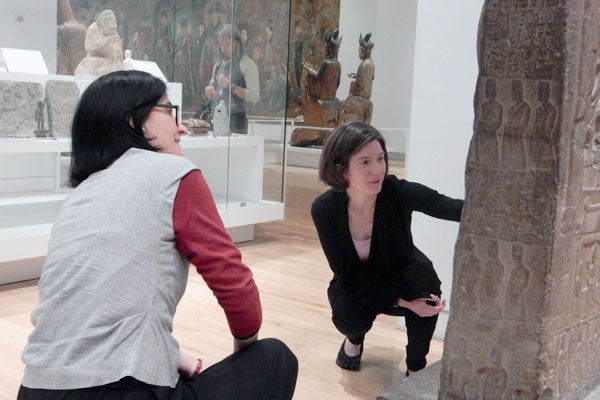
Medieval art, history collaboration bring together China's Guangzhou Academy of Fine Arts, U of T
Published: May 25, 2015
Medieval art and art history are bringing together faculty and students from the University of Toronto and the Guangzhou Academy of Fine Arts (GAFA) in China.
Global and Postglobal Perspectives on Medieval Art and Art History, a three-year collaborative initiative, is funded by the Getty Foundation, a philanthropic organization that supports the greater understanding and preservation of the visual arts in its home city of Los Angeles and around the world. The collaboration is part of the foundation’s Connecting Arts Histories initiative, an effort that “aims to increase opportunities for sustained intellectual exchange across national and regional borders.”
“U of T and the Guangzhou Academy of Fine Arts are working together to make art history a more global discipline,” said U of T's Jennifer Purtle, an associate professor specializing in Chinese art and principal investigator for the project.
Beginning this fall, three U of T professors and a research fellow affiliated with the Pontifical Institute of Mediaeval Studies will take turns teaching in Guangzhou, while a fourth U of T professor anchors the program in Toronto. At GAFA, U of T faculty will offer both undergraduate courses and graduate seminars, principally in medieval art and art history methodology. One GAFA professor will teach medieval Chinese art history at U of T during the three-year period.
Graduate students at U of T and GAFA will enroll in identical medieval art history courses, including ‘Making Pictures in Medieval China’ and ‘Multicultural Arts of Medieval Sicily.’ At the conclusion of each graduate course, faculty and students from both institutions will undertake field trips to study works of art first hand in Sicily and Dunhuang, China.
“Over the course of three years, this will happen twice,” said Adam Cohen, one of the U of T art historians participating in the initiative. “The best way to learn is to go and see the art and architecture and transfer theoretical knowledge into seeing how things really operate. As much learning will happen there as in class.
“We hope to build lasting ties among the next generation of scholars.”
 It is the current generation of scholars that has made this cross-cultural exchange possible. U of T’s Purtle and GAFA’s Yudong Wang have worked together since the early 2000s, when Wang was a PhD student and Purtle was an assistant professor at The University of Chicago.
It is the current generation of scholars that has made this cross-cultural exchange possible. U of T’s Purtle and GAFA’s Yudong Wang have worked together since the early 2000s, when Wang was a PhD student and Purtle was an assistant professor at The University of Chicago.
“Professor Wang is part of the first wave of PhDs who have returned to build the discipline of art history in China,” said Purtle. “Until recently, art history was not a university subject in China. Students studied archeology instead.”
(Pictured above right: U of T and GAFA scholars Jill Caskey, Qingquan Zou, Adam Cohen, Yudong Wang, Linda Safran, Qingquan Li at Guangzhou Academy of Fine Art; photo by Xiaoshan Xian)
U of T faculty will help build art history in China by providing training in Western art history and methodology not otherwise available in China, while GAFA faculty will expand offerings in Chinese art history at U of T, said Purtle.
“This will better prepare young Canadian and Chinese scholars to participate in the discipline of art history at the global level.”
The collaboration will offer participating students and faculty a chance to expand their perspectives on art history.
“Being interdisciplinary and more global isn’t just theory,” said Cohen. “We have an opportunity to put it into practice.”



